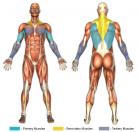Reverse Lat Pull-Downs (Machine)
Performance Description
- Adjust the thigh pad height so that, when seated, by pressing slightly with your toes your legs will remain firmly planted on the ground, thereby keeping your body from moving.
- Face the machine, sit, and position your thighs beneath the pads.
- Grasp the bar in underhand position (i.e. palms facing away from one another) at shoulder-width or less.
- Pull the bar to your upper chest or nipple line, keeping your body upright and puffing out your chest, exhaling throughout the movement. Your elbows should be pointing forward.
- Slowly lower the weight to the starting position, letting your arms fully extend (without letting your elbow joint slam as your arms straighten), inhaling throughout the negative motion.
- Repeat steps 4-5 for as many repetitions as are desired.
Primary Muscle(s)
Biceps (Biceps Brachii: Long 'Outer' Head)
Biceps (Biceps Brachii: Short 'Inner' Head)
Biceps (Brachialis)
Lats (Latissimus Dorsi)
Outer Back (Teres Major)
Secondary Muscle(s)
Upper Back (Rhomboid Major)
Upper Back (Trapezius)
Tertiary Muscle(s)
Chest (Pectoralis Major)
Forearms (Extensor: Carpi Ulnaris)
Forearms (Extensor: Digiti Minimi)
Forearms (Extensor: Digitorum)
Further Clarification
Reverse lat pull-downs are an excellent alternative exercise to reverse pull-ups/reverse chin-ups. Being able to adjust the weight to more of less than your body weight makes this exercise appealing to both novice and advanced weight lifters. Though, if possible, do not replace reverse pull-ups/reverse chin-ups with reverse lat pull-downs, as most experts believe the former to be the better exercise.
Also, note that the reverse grip transfers a significant amount of the work from the back to the biceps.
Things To Look Out For
Do not use your body weight to pull the bar down, all motions should be well controlled with emphasis on the lats and biceps doing the work.
Level
Beginner
Exercise Position(s)
Seated
Exercise Variations
Considered An Exercise In The Following Categories





